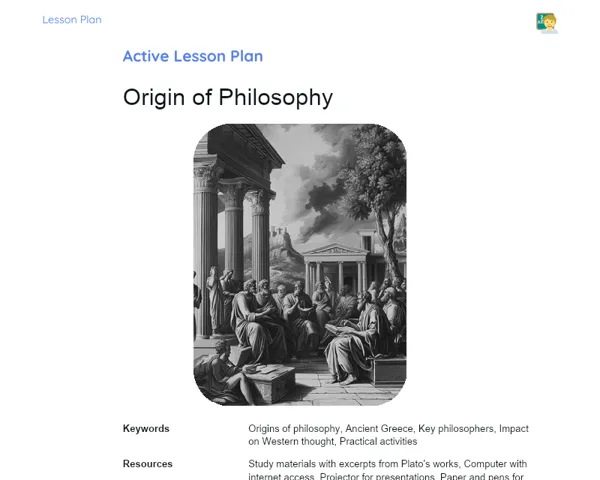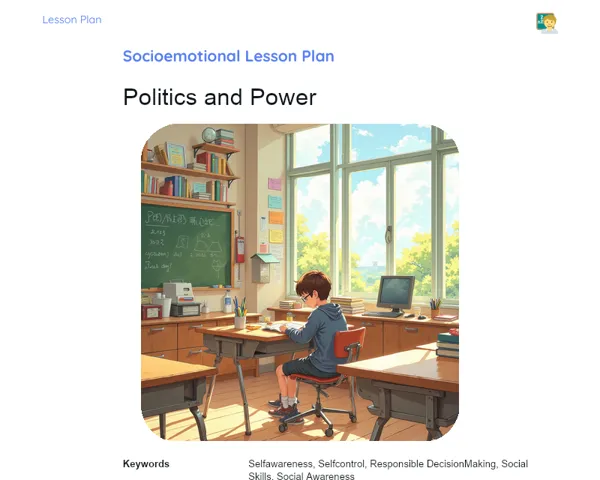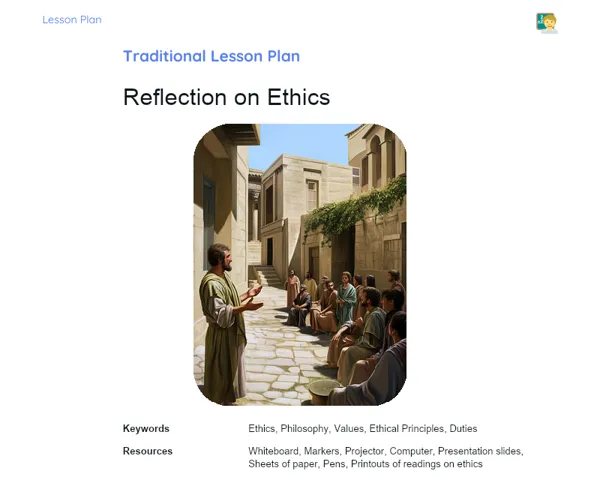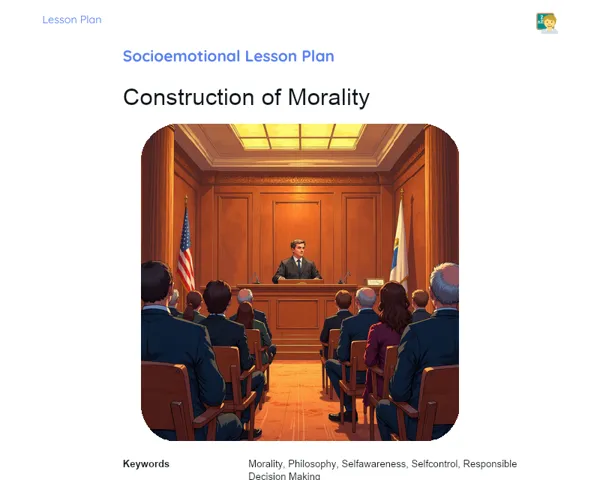Lesson Plan | Lesson Plan Iteratif Teachy | Politics and Power
| Keywords | Politics, Power, Philosophy, Social Media, Electoral Campaign, Political Simulation, Documentary, Digital Methodology, Critical Thinking, Civic Engagement, Involvement, Practical Activities |
| Resources | Mobile phones or tablets with internet access, Instagram accounts, Content creation tools (e.g., Canva, Adobe Spark), Political simulation platform (e.g., SimCity, Democracy 3), Shared documents (e.g., Google Docs), Video editing software (e.g., iMovie, Windows Movie Maker), Computers or laptops with internet access, PowerPoint presentations or similar, Projector or Smart TV for video presentations |
| Codes | - |
| Grade | 12th grade |
| Discipline | Philosophy |
Goal
Duration: (10 - 15 minutes)
The aim of this lesson plan is to equip learners with a comprehensive understanding of power and politics and their intricate interconnections. This will enable students to engage actively in further practical activities, allowing them to apply theoretical knowledge to current and pertinent situations.
Goal Utama:
1. Gain insight into the historical and philosophical foundations of power.
2. Examine the relationship between power and politics across various social and historical contexts.
3. Discuss how the political environment influences the perception and exercise of power.
Goal Sekunder:
- Encourage analytical thinking about current political happenings.
- Promote research into diverse political theories and their implications in contemporary society.
Introduction
Duration: (15 - 20 minutes)
🔍 The intention of this phase is to engage students right from the get-go, encouraging them to use digital tools to explore the topic and share their findings in the classroom discussion. This facilitates a connection with students' contemporary digital reality and promotes a collaborative and dynamic learning context, which is essential for Digital Methodology.
Warming Up
🔃 Warm-Up: Inform the students that today’s class is centred around 'Politics and Power'. Ask them to utilise their mobile phones to find an interesting fact about the topic, be it a historical nugget, a philosophical theory, or a recent political occurrence. Give them about 3 to 5 minutes for this task and then invite them to share their discoveries with the class.
Initial Thoughts
1. What does power mean to you? How would you describe this concept?
2. How can politics shape power, or the other way around?
3. Can you think of some historical or current examples of power dynamics in politics?
4. Do you see power as inherently negative? Why or why not?
5. In what ways can social media impact the dynamics of political power?
Development
Duration: (70 - 75 minutes)
⚡ The goal of this segment is to deepen learners' understanding of the concept of power and its connections to politics through hands-on digital activities. These tasks encourage the practical application of theoretical knowledge in modern contexts, fostering collaborative learning and critical thinking skills among students.
Activity Suggestions
Activity Recommendations
Activity 1 - 👤 Create an Electoral Campaign on Instagram
> Duration: (60 - 70 minutes)
- Goal: Understand the impact of social media on politics and power while developing skills in persuasion and digital marketing relevant to the political sphere.
- Deskripsi Activity: Students are to devise a fictional electoral campaign on Instagram, with each group representing a candidate embodying a distinct political ideology. They must develop posts, videos, and stories to promote their candidate while exploring the mechanisms of power and political persuasion.
- Instructions:
-
Divide the class into groups of up to 5 students.
-
Each group should select or draw lots for a fictional candidate and define their political ideology.
-
Students are required to create an Instagram profile for the selected candidate.
-
Produce digital content, including static posts, videos, and stories that highlight the proposals and persona of the candidate, using tools like Canva or Adobe Spark to create quality graphics and videos.
-
Encourage the use of hashtags, polls, and other interactive Instagram features to boost engagement.
-
Each group will have 40 minutes to develop and publish their content. In the final 20 minutes, groups will present a brief overview of their campaign to the class.
Activity 2 - 🎮 Political Simulation Game
> Duration: (60 - 70 minutes)
- Goal: Experience decision-making in political and economic contexts, appreciating the impact of policies on power and society.
- Deskripsi Activity: Students will take part in an online political simulation game, using platforms like 'SimCity' or 'Democracy 3'. They will be divided into groups and must manage a city or a country, making political and economic decisions that affect society practically.
- Instructions:
-
Split the students into groups of up to 5 people.
-
Guide the students to connect to the chosen simulation platform.
-
Each group will take control of a city or country and make political and economic decisions, applying the concepts of power and politics discussed.
-
Ask them to record their key decisions and outcomes in a shared document (Google Docs).
-
In the concluding 15 minutes, each group should present their main decisions and the outcomes observed, elaborating on how power was exercised and its effects.
Activity 3 - 🎥 YouTube Documentary on Political Movements
> Duration: (60 - 70 minutes)
- Goal: Investigate historical or contemporary political movements, understanding their strategies for power and societal impacts.
- Deskripsi Activity: Students must create a mini documentary lasting 5 to 7 minutes using YouTube to highlight a significant political movement. Each group will choose a movement, researching its origins, strategies for power, and societal impact.
- Instructions:
-
Organise the students into groups of up to 5 people.
-
Each group will select a notable political movement (e.g., Arab Spring, Suffragist Movement, etc.).
-
Conduct thorough research about the chosen movement using reliable academic sources.
-
Utilise mobile phones and basic video editing software (like iMovie or Windows Movie Maker) to record and edit the documentary.
-
Encourage the inclusion of interviews, voiceovers, archival images, and explanatory graphics.
-
In the last 20 minutes, groups should upload their videos on YouTube and present a brief overview of their documentary to the class.
Feedback
Duration: (20 - 25 minutes)
🏆 Purpose: This phase aims to solidify learning and encourage critical reflection through sharing experiences and constructive feedback. This final discussion helps learners consolidate the concepts covered while promoting skills in communication, collaboration, and self-reflection.
Group Discussion
🔵 Group Discussion: Conduct a group discussion with all students, where groups share their learnings from the activities and their overall conclusions. Suggested outline:
- Introduction: Briefly state the aim of the discussion and how it connects to the studied theme.
- Sharing: Invite each group to summarise their key discoveries and insights from the activities.
- Debate: Encourage students to pose questions to other groups, fostering an exchange of ideas and reflections.
- Conclusion: Summarise the key points discussed and their relation to the concepts of power and politics explored.
Reflections
1. How did different groups interpret the notion of power in their tasks? 2. What effective persuasion and political influence tactics did you observe? 3. In what ways did the activities enhance your understanding of the relationship between power and politics in the current world?
Feedback 360º
🔄 360° Feedback: Instruct students to engage in a 360° feedback session, where each student receives feedback from their group members. Feedback guidelines:
- Be specific: Share concrete examples of observations made.
- Balance praise and suggestions for improvement: Offer positive comments alongside areas for growth.
- Maintain respect: Keep a respectful and constructive tone throughout.
Conclusion
Duration: (10 - 15 minutes)
🎯 Purpose: This segment aims to wrap up the day’s learnings in a light-hearted and interactive manner, prompting students to reflect on the importance of the topic discussed. By linking classroom content with real-world applications, the conclusion reinforces the significance of learning and encourages ongoing student engagement with the subject matter. This final reflection is crucial in helping students internalise the concepts addressed and inspires them to apply this knowledge in their daily lives.
Summary
🌀 Fun Summary: To round off, let’s take a quick spin on the rollercoaster of knowledge! 🚀 Today, we navigated the complex landscape of Power and Politics. We kicked off by defining what power is and how it interlinks with politics. Students excelled in practical activities, such as creating Instagram electoral campaigns and managing cities in simulation games. Each group explored different facets of political power, from digital campaigns to documentaries about historical movements. It was a real educational adventure! 🎢
World
🌍 In the Current World: Today's lesson is directly tied to contemporary realities, where digital platforms and social media play pivotal roles in politics. With politicians and activists utilising Twitter, Instagram, and YouTube to share their messages, understanding the dynamics of power in the digital age has never been more pertinent. This connection helps students grasp how power is exercised and perceived in today’s world.
Applications
📚 Applications: Grasping the relationship between power and politics is vital for informed citizenship. It enables a critical interpretation of daily news and empowers students to actively engage in the democratic process, whether by voting wisely or by crafting content that advances significant social or political causes. The insights gained here are directly applicable to the conscious and critical use of digital media and civic engagement.



